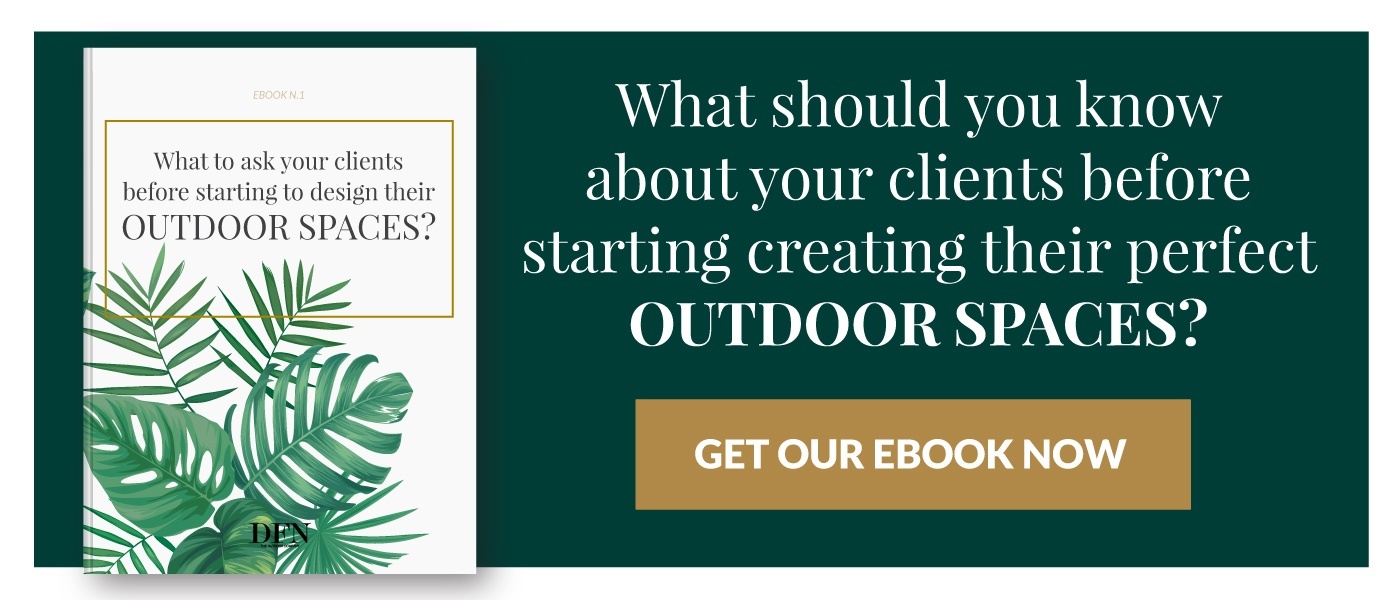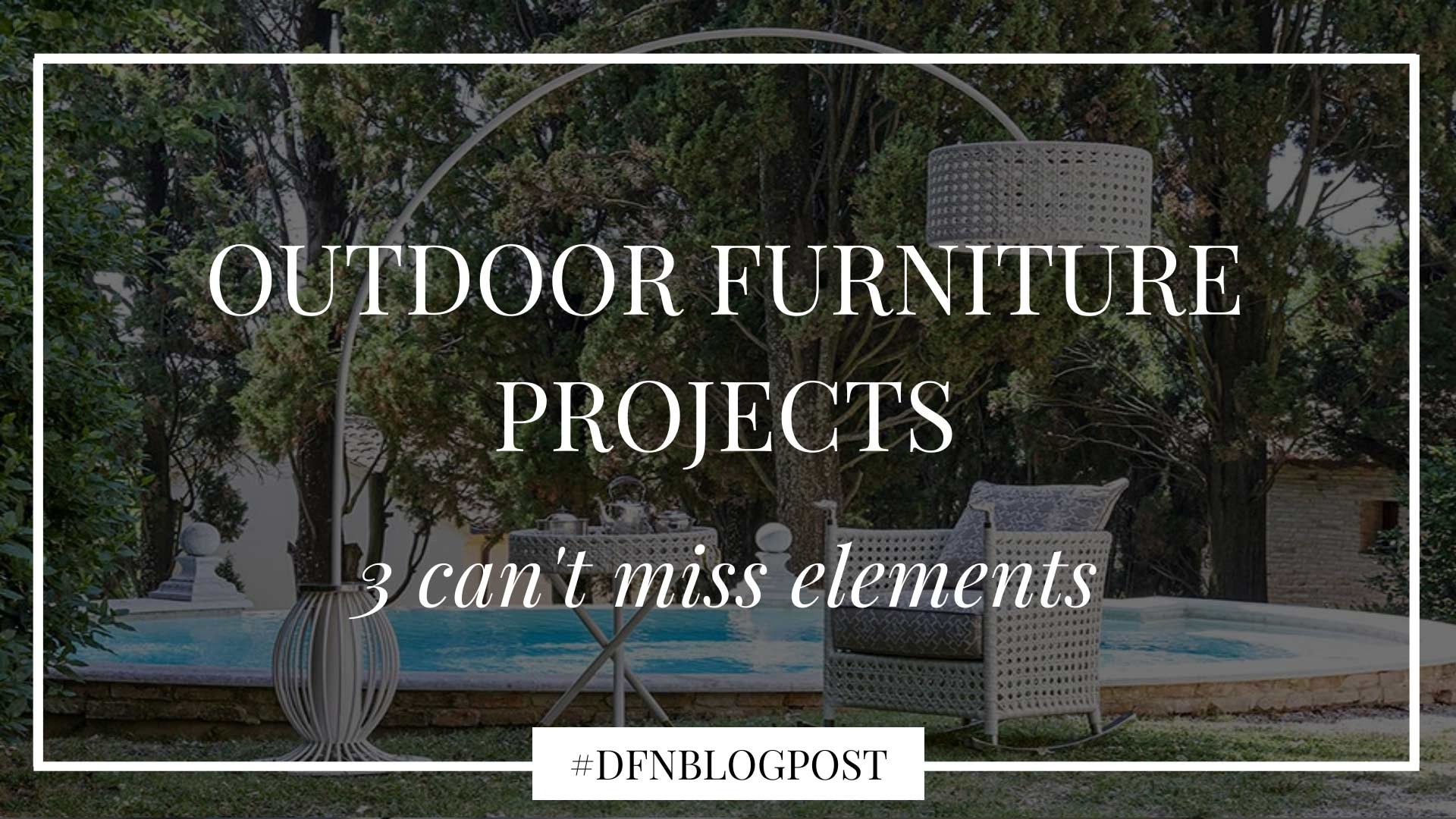
Whether we do it for work or passion, what we are experiencing is a golden age for those in the outdoor furniture sector. Companies and the market have never before devoted so much interest to outdoor furniture.
Quality and attention to detail have become typical of interior furnishings, which is a testament to the fact that there is no longer a clear separation between indoor and outdoor furnishings.
Today, the space outside the home is experienced as if it were one of the many "rooms" within, a sort of open-air living room, an area that should be experienced in full, alone or in the company of friends and relatives, possibly throughout the year.
Therefore, outdoor furniture must be able to meet several different needs: they must express the owner's style and personality, ensure relaxation and comfort and allow people to fully enjoy the days or evenings spent outdoors. Both from a decorative and functional point of view, it is essential to choose the right outdoor furniture to get the most out of your outdoor spaces.
In this article, we will present three important elements of outdoor furniture that cannot be missing, three fixed points on which the designer can base their activity, in the midst of the sea of possibilities offered by the endless range of products available today.
We will talk about:
- The creation of a relaxation area that gratifies the body as much as the mind
- The use of atmospheric and functional lighting
- The choice of products that guarantee comfort and durability
The creation of a relaxation area that gratifies the body as much as the mind
The garden, patio, or terrace are places dedicated to free time and are linked to the concept of relaxation. Therefore, a relaxing atmosphere is a necessary prerequisite for the creation of an ideal outdoor space. Beauty and comfort are key to this result: the former relaxes the mind, the latter gratifies the body.
Therefore, it is necessary to carefully select the type of furniture most suitable to recreate an oasis of peace. The most representative piece of furniture, from this point of view, is the outdoor sofa. It is comfortable and elegant, and you can simply place one or more of them in the garden or on the terrace to transform them into real open-air living rooms.
There are sofas of all types and sizes, armchairs and sofas: the designer can indulge themselves and find the most suitable style for the context of the house every time. A good idea is to opt for modular outdoor sofas, which can be set up in a different and personalized way, according to the available space and needs.
Another fundamental type of furnishing for an outdoor relaxation area is the sun lounger. Having beds on hand allows you to relax, rest or sunbathe on the brightest days. There are simple models for swimming pools, reclining or not, and also canopies to protect from sun exposure. Halfway between the seat and the bed is chaise longues.
The options for relaxing outdoors don't end there. Hammocks or swing seats, for example, allow you to enjoy the breeze, swinging gently. Poufs are also beautiful to look at and can represent a simpler alternative to sofas.
Even benches are interesting tools when the spaces are not big, perhaps to create a terrace seat, especially if strategically positioned in the places where the view is better or more suggestive. In fact, the visual element is particularly important for finding inner tranquility. Flowers and plants are essential in this respect, as are beautiful vases, statues, or a pleasant panorama.
Among the elements, water is what most refreshes the spirit. Go ahead, add fountains and ponds or small lakes, perhaps with the fish swimming inside. The sound of flowing water is often enough to relax the muscles and calm the mind.
The perfect relaxing atmosphere also involves the sense of smell. In addition to flowers, natural perfume or essential oil diffusers or fragrant candles can be used because they are so evocative and often useful for keeping insects away.
Finally, the relaxation area must be sufficiently shaded. Trees can be a pleasant cover, but they also have several drawbacks, such as leaves or falling fruits. It’s better, in some instances, to equip yourself with umbrellas, sails, or other shades.
The best option is probably a gazebo or orangery. These are important outdoor structures that offer shelter, guarantee a reassuring sense of protection, and can be equipped with all sorts of comforts. At the same time, they allow you to enjoy the garden view, even in winter, and look at the stars.
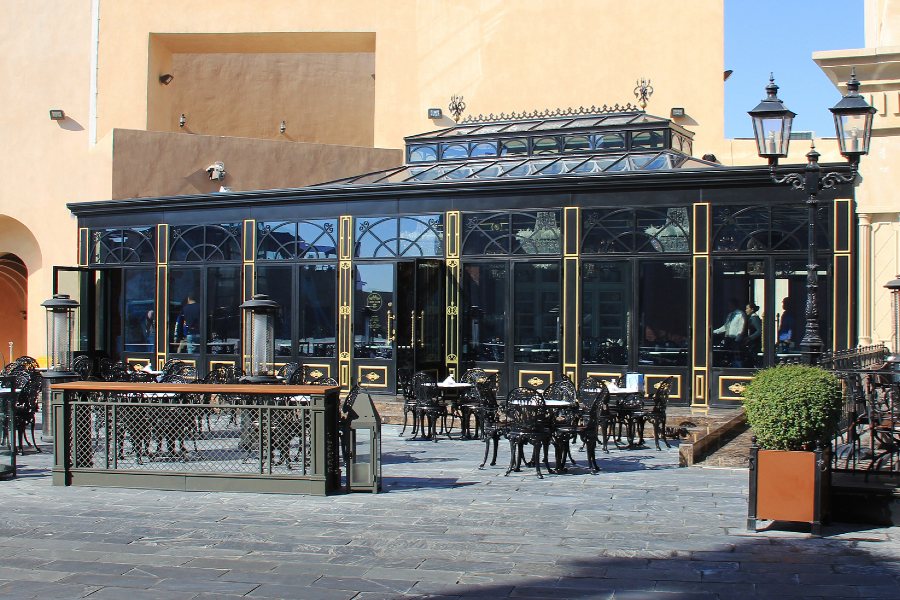
Light, another important element of outdoor furniture
On warm spring or summer days, it is difficult to resist the pleasure of being outdoors even in the evening. What's better than a cool evening in your garden with the people you love?
In winter, on the other hand, the days are shorter, and it gets dark earlier. To extend the use of outdoor spaces even at night, you should provide for proper lighting.
Appropriately choosing the type and arrangement of the lights is an important element of outdoor furniture. They are essential for the functionality of the space and ensure that they are used safely even in the darkest hours. They are also relevant from an aesthetic point of view, both to enhance the appearance of the furniture, and to create refined and elegant scenarios, capable of enriching the sensorial experience of your own outdoor space.
That’s why we turn to scenographic lighting: the set of lights designed to exploit the play on shadows and light and dark that have an emotional purpose or highlight the most valuable elements of the furniture: fountains, decorations, trees, and even the most valuable furniture, from tables to seats, or the most important corners (lounge, swimming pool, outdoor kitchen and so on).
Scenographic lighting tests the designer's creativity and their ability to work on details and nuances. Whether you choose street lamps, lamps or spotlights, it is advisable to opt for diffused light, because direct light can have an annoying dazzling effect.
Cold lights are usually chosen in combination with modern furnishings, and warm lights are used with more traditional ones, but more and more often the two categories are mixed together, to obtain new suggestive effects. Generally, it is a personal choice, linked to the taste of the individual designer or homeowner.
As already mentioned, the study of lighting cannot be limited to mere scenic effects but must also allow you to experience the outdoor spaces in the evening hours in tranquility and safety. We are talking about spotlights or lanterns that illuminate the paths, or lights that allow you to see the entrance door well.
In general, lighting concerns all areas of the external space that are actually experienced and used by people. So, let's not forget to illuminate the swimming pool, the patio, the eventual gazebo or the interior of the conservatory, the outdoor kitchen and the bar well.
In the latter cases, where drinks or food are prepared, the intensity of the lights will have to be assessed more carefully, to allow the chef or barman to perform at their best.
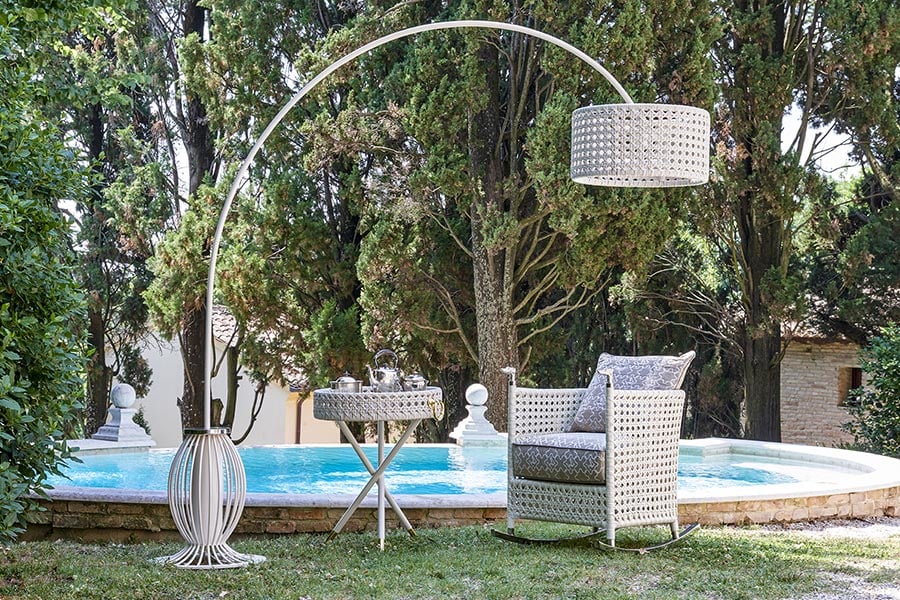
The third important element of outdoor furniture: quality
Quality outdoor furniture is an investment made to last. No one wants to find themselves, shortly after making the purchase, having to change their furniture because it wasn’t able to withstand the atmospheric conditions, wear, and bad weather.
Therefore, any element of your garden or terrace must be of high-performance to guarantee usability and comfort despite the stress it is subjected to.
From this point of view, the type and quality of the materials are fundamental. It is necessary to choose only the best, capable of combining excellent technical characteristics and high aesthetic value.
Of the metals, iron, aluminum, and steel are the most widely used. The first, extremely solid and resistant, has a classic charm of its own. In the case of outdoor furniture, the iron must be treated specifically to resist the most aggressive climatic conditions. In quality products then, after a special treatment that serves to make the surface unassailable, it is powder coated, a cover that ensures an excellent degree of protection.
Aluminum is the light metal par excellence, easy to transport and, therefore, particularly suitable for becoming the supporting structure of furniture that can be moved: for example, chairs, armchairs, sofas, or coffee tables. It does not rust, does not require much maintenance, and is easy to shape in the most varied forms.
Steel is the most robust and also guarantees an excellent aesthetic result. Its reliability in any situation makes it the ideal material for furniture that is more subject to aggressive agents, such as those in outdoor kitchens, where greater wear and tear and continuous contact with sources of heat, various types of detergents, and foods are added to the atmospheric elements.
Natural materials historically used for outdoor furnishings, such as rattan, wicker and parchment, guarantee great aesthetic impact, lightness and, at the same time, a high level of comfort. They are entirely handmade, a feature that confers prestige and attention to detail otherwise difficult to obtain.
In any case, these are delicate materials, so it is advisable to use them above all in the most sheltered areas, for example, under gazebos, verandas or porches or inside an orangery. In this way, their beauty can be preserved for decades, away from rain and direct sun exposure.
A very valid alternative to natural materials is the new generation synthetic fibers, for example, synthetic rattan. This type of material reproduces the characteristics of natural rattan. Before processing, it is presented in the form of a ribbon and is woven by hand, like natural materials, around the load-bearing structures of the furnishings, creating large intertwined textures of great charm. Unlike the natural fibers it imitates, synthetic rattan resists the most difficult climatic conditions, without losing its characteristics.
The quality of the products is not only a matter related to the materials, but also to the invoice. A good starting point for choosing your furniture is to carefully select only the best manufacturers, capable of guaranteeing a state-of-the-art production and maybe even recommending the right solutions according to the different contexts.
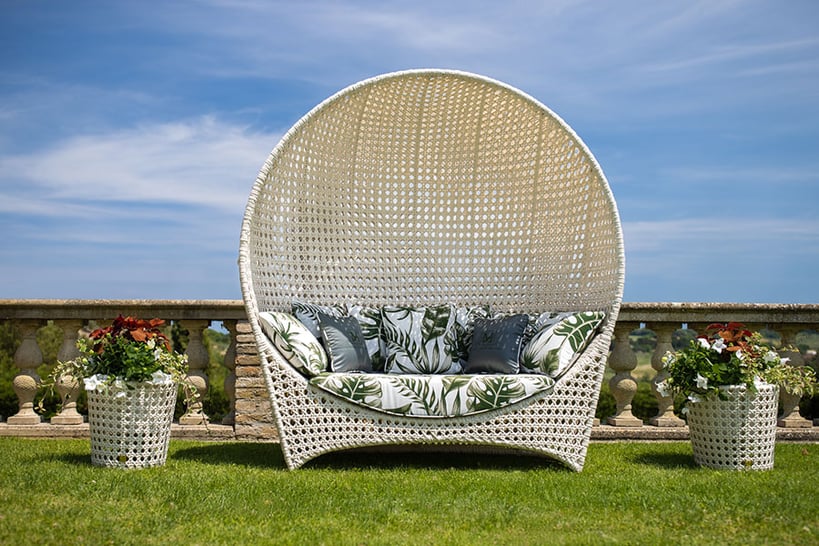
In conclusion
In this article, we wanted to list the three most important elements of outdoor furniture, the characteristics that cannot be missing when designing a garden or a terrace. We limited ourselves to three because we believe that, in this way, the "rule" is sufficiently counterbalanced by the possibility of discretion on the part of the designer. Too many impositions, in fact, run the risk of depressing the imagination of creatives.
In any case, the few aspects that we have suggested seem ironclad. Attention to the main function of an outdoor domestic area, relaxation; lighting design that does justice to the furniture and makes it usable even in the evening; the choice of the right furniture, comfortable and at the same time capable of resisting sun, rain, humidity, and corrosion: the foundations for an outdoor space that can best enhance the entire home.



